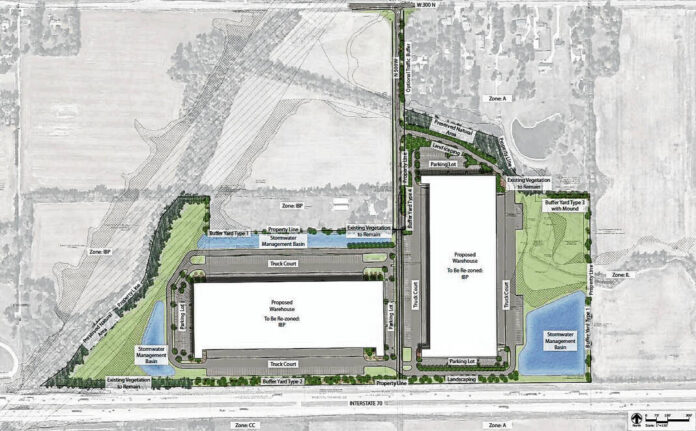
Indianapolis-based i3 Investors wants to develop two buildings totaling about 1.3 million square feet at the northeast and northwest corners of I-70 and CR 500W in Hancock County.
Submitted image
HANCOCK COUNTY – A developer and county officials have struck a deal over a project involving two large buildings through an agreement outlining benefits to both sides.
The accord includes payments to the county for schools and safety, a tax break for the developer, a new traffic circle for motorists and even protection for a historical oak tree. While all elected decision-makers approve, the same cannot be said for all residents living near and on the future site.
Indianapolis-based i3 Investors plans to develop an industrial logistics project consisting of two buildings totaling about 1.3 million square feet flanking CR 500W north of I-70. Estimated at about $104 million, the project is currently speculative, meaning without occupants yet determined.
The Hancock County Commissioners and i3 Investors signed an economic development agreement for the project earlier this month. That document calls for i3 to make economic development payments to the county. Amounts will be determined by multiplying the percentage for a given year outlined in a schedule in the agreement by the amount of real property tax that would be owed in that year in the absence of a tax abatement. For example, the percentage called for in year five is 20%, meaning that if the amount of real property taxes owed in that year would be $1 million in the absence of an abatement, the payment would be $200,000. The schedule starts out at 0% in year one and gradually rises to 45% by the 10th and final year.
County officials intend to use economic development payments for public safety and education purposes.
According to the economic development agreement, i3 Investors will contribute $825,000 to the construction of a traffic circle at CR 500W and CR 300N, about 25% of the total estimated cost.
The agreement also calls for bonds to be issued generating $3 million for infrastructure improvements, which include reconstructing CR 500W to two 15-foot-wide travel lanes with 2-foot shoulders, a cul-de-sac turnaround at the south end of the road, and related utility costs. Half of the real property taxes generated by the development will go toward paying off the bonds.
Additional landscaping, mounding and fencing to buffer the development from neighbors is outlined in the agreement as well, as is the preservation of a historical oak tree championed by Leah Lederman, whose home i3 is buying for the project. If the county’s drainage board ever determines the tree would need to be removed, however, that would fall outside of the developer’s commitment.
The Hancock County Council unanimously approved a confirming resolution for a tax abatement for the buildings. Real taxes from the development will be fully abated in their first year before the break gradually diminishes over time until year 10 when taxes will be fully phased in.
The passing of the economic development agreement and tax abatement marked the end of the main approvals needed for the project, which has been contentious at times ever since it first started to be publicly discussed in May.
“We’re trying to be amenable to the requests of the neighbors and of the county,” Matt Dickerson, managing member of i3 Investors, said at a county council meeting earlier this month. “We’re local folks and we’re just trying to do the best job we can. … We recognize and realize our process is disruptive. … Some folks aren’t going to be happy, but we’ve certainly tried to listen to as many as we can.”
Tony Barnett, who lives near the site, said he took from past public meetings that i3 Investors would pay for all infrastructure improvements needed for the project.
Keely Butrum, a county council member, called that a misunderstanding and noted that the county’s agreements with many other speculative warehouse developers also call for infrastructure improvements to ultimately be paid for via taxes generated by the respective developments.
Barnett also took issue with the provision requiring i3 Investors to foot only 25% of the cost for the traffic circle.
Officials intend to have the remaining 75% ultimately come from the Hancock County Redevelopment Commission, which oversees the county’s tax increment financing districts. TIF districts capture taxes from new development to be used to benefit their respective areas. The intersection the traffic circle is slated for is in a TIF district that’s been capturing new taxes from western Hancock County’s building surge.
“Nobody wants the individual taxpayers all over the county to foot the bill for 75% of the roundabout, and that won’t be what happens,” Butrum said.
Barnett also said he feels the traffic circle will only benefit i3 Investors’ development and wouldn’t be needed otherwise. Council members disagreed, saying one has been needed to calm traffic in the area and that i3’s project presents an opportunity to get it quicker.
“The roundabout finalization was not decided on because i3 needed it, it was decided on because of the amount of traffic that is produced on 300,” council member Mary Noe said.
Lederman, an outspoken opponent of the project since its beginnings, reiterated her concerns about the development’s proximity to Mt. Comfort Elementary School, increasing traffic near a nearby pioneer cemetery, and impacts to air quality from the removal of green space coupled with additional traffic and construction.
“None of the concerns I’ve raised over the last six months are invalid,” she said.




